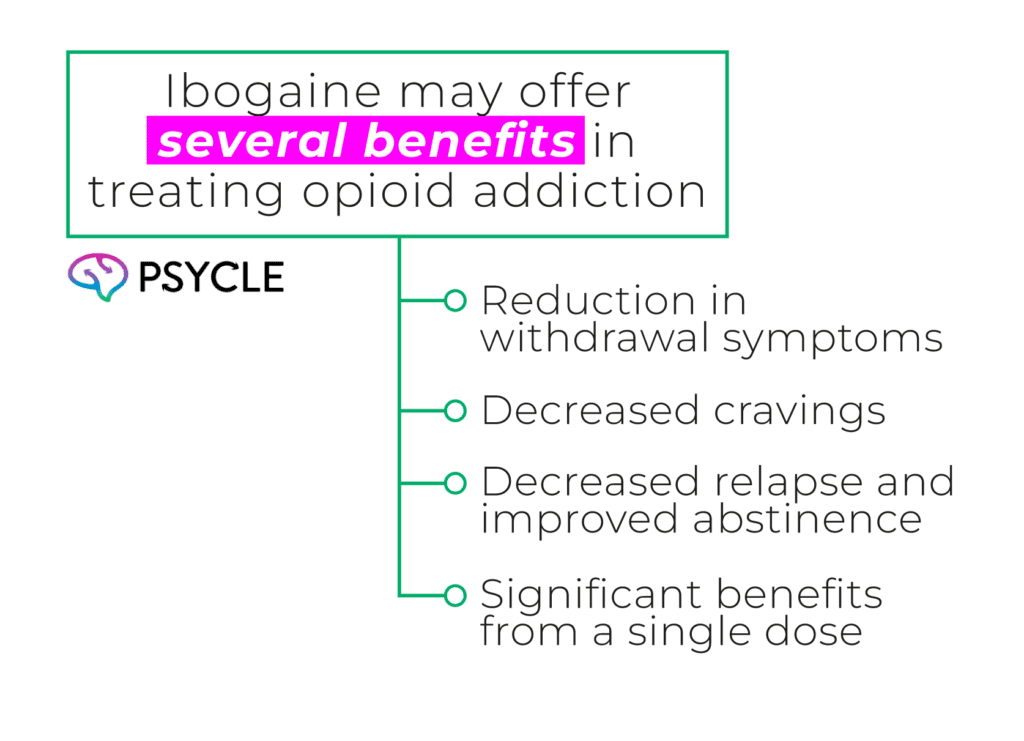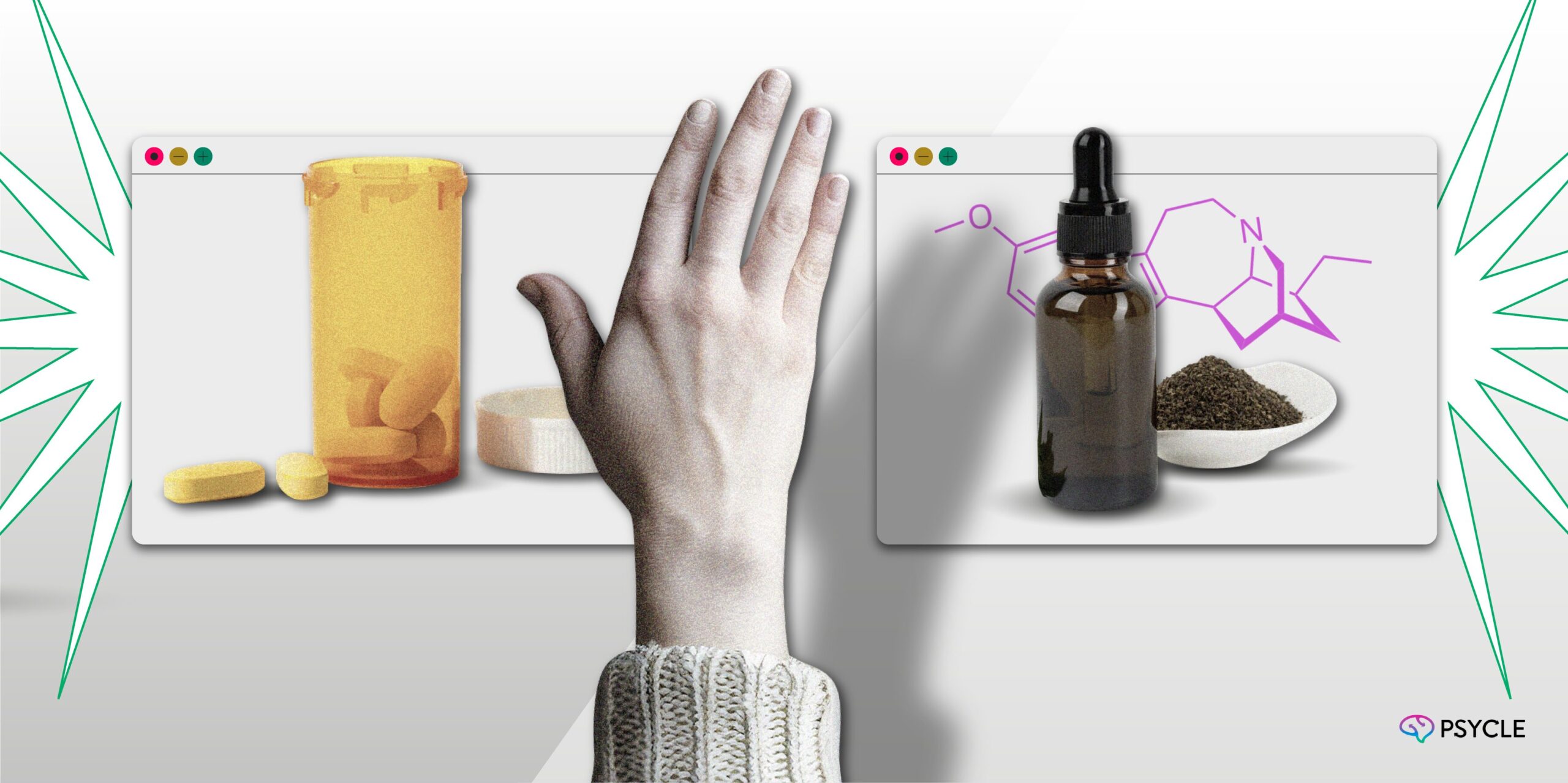Opioid addiction is a devastating public health crisis, claiming hundreds of lives every day. In this article, we’ll be exploring ibogaine–a plant-derived psychedelic–as a potential solution for addressing this epidemic. This article explores the potential of ibogaine in opioid addiction treatment, including its mechanisms of action, benefits, risks, and legal status.
Key Takeaways
- Opioid addiction is a major crisis. Millions are affected worldwide, with high overdose rates and severe withdrawal symptoms making recovery difficult.
- Standard treatments have limitations. Medications like methadone and buprenorphine help but often require long-term use and have high relapse rates.
- Ibogaine shows promise. It interacts with multiple brain systems, reduces cravings, alleviates withdrawal symptoms, and may help reset addiction pathways.
- Ibogaine has risks and legal barriers. While some countries allow ibogaine treatment, its potential heart risks and hallucinogenic effects require further research and regulation.
The Need for Effective Opioid Addiction Treatment
Opioid addiction is a widespread crisis, affecting millions of people worldwide. Data from the Centre for Disease Control estimates that 224 people die everyday in America due to opioid overdose. This prevalence is driven by the highly addictive nature of opioids, which are often prescribed for pain, such as oxycodone and morphine, but can quickly lead to dependence.
Opioids are problematic because they not only create intense cravings but also cause severe withdrawal symptoms—such as nausea, muscle pain, anxiety, and depression—when use is stopped. These withdrawal effects make quitting extremely difficult, trapping many individuals in a cycle of addiction.
Standard treatment for opioid addiction involves using weaker opioids, such as methadone and buprenorphine, to reduce cravings and withdrawal symptoms. However, these drugs often require long-term use and can be difficult to access. While they help many people, relapse rates remain high, and some individuals struggle with dependence on these medications themselves. Because of these limitations, there is a strong need for new treatments that provide more effective, long-lasting solutions for opioid addiction.
Origins of Ibogaine
Ibogaine is the main active compound in the Tabernanthe iboga shrub, which grows naturally in West Africa. It has psychedelic effects that some describe as shifting between dreamlike and waking states, and native people in the region have long-valued these visionary experiences. The Bwiti people of Gabon consider iboga sacred and use its bark in high doses for coming-of-age and initiation ceremonies.
In the early 1900s, French explorers brought iboga back from Gabon to Europe. Ibogaine was isolated and marketed in France as a stimulant drug in the 1960s under the name Lambarène.
Ibogaine’s anti-addictive properties were first documented by Howard Lotsof, who discovered a single dose significantly reduced his cravings for heroin. Lotsof began studying ibogaine’s effects on individuals with various addictive disorders, particularly opiate and cocaine dependence.
In these early studies, patients experienced a significant reduction in craving, withdrawal, and relapse, leading to the development of larger ibogaine clinical trials. The drug has since become legal for addiction treatment in certain countries.
How Does Ibogaine Treat Opioid Addiction?
Ibogaine works differently from other addiction treatments by affecting multiple neurotransmitter (chemical messenger) systems in the brain. Here are some of ibogaine’s key mechanisms of action:
Interaction with Opioid Receptors
Ibogaine attaches to mu-opioid receptors, the same sites where opioid drugs take effect. This may help prevent withdrawal symptoms, which happen when these receptors go from constant activation to sudden inactivity. By binding to the receptors without fully turning them on, ibogaine helps ease the body into a smoother transition away from opioid dependence.
Interaction with Dopamine
Dopamine is a neurotransmitter that controls reward and pleasure. Long-term opioid use disrupts dopamine signaling, making everyday rewards feel less satisfying and reinforcing drug use. Ibogaine helps by temporarily blocking dopamine from being re-absorbed by cells, boosting natural pleasure responses, and reducing cravings.
Release of Growth Factors
Ibogaine promotes the release of growth factors, which are molecules that help aid the survival and growth of nerve cells. These factors could help restore damage to the brain caused by opioid use. Studies show ibogaine increases growth factors such as nerve growth factor (NGF) and brain-derived neurotrophic factor (BDNF) in nerve circuits associated with addiction. Researchers have suggested that ibogaine may help “reset” these brain pathways.
Psychedelic Effects
High doses of ibogaine can induce an altered state of consciousness, where individuals often experience vivid visions and heightened introspection. During this process, they may gain valuable insights into past trauma, emotional pain, or unresolved issues that could be contributing to the root of their addiction. These experiences can aid talk therapy and help the cycle of addiction.
Benefits of Ibogaine in Addiction Treatment

Anecdotal reports and preliminary studies suggest that ibogaine may offer several benefits in treating opioid addiction:
Reduction in Withdrawal Symptoms
In a study of 50 participants with opioid addiction, 78% showed no clinical signs of withdrawal symptoms at 48 hours after a single ibogaine dose.
Decreased Cravings
In the same study as above, 79% of participants had minimal cravings for opioids at 48 hours post ibogaine.
Decreased Relapse and Improved Abstinence
According to data, an estimated 71-80% of those with opioid dependence with relapse within one month of treatment. One study found that 70% of opioid users treated with ibogaine had a relapse following treatment, but 48% reported notably decreased opioid use from pretreatment levels.
Moreover, the time to relapse was significantly longer, with 54% of participants abstaining for at least one year.
Significant Benefits From a Single Dose
Ibogaine differs from typical opioid treatments because it is not taken daily or long-term. Instead, it is typically used as a one-time or short-term intervention.
Risks and Side Effects
While ibogaine may offer benefits, it also carries serious risks.
Cardiac Complications
Ibogaine has been associated with heart-related issues, including arrhythmias (irregular heartbeats), which can be fatal. It can prolong the QT interval, a measurement of electrical activity in the heart, increasing the risk of sudden cardiac arrest. As such, those with pre-existing heart conditions are strongly advised against using ibogaine.
Psychological Effects
Ibogaine is a powerful hallucinogen. Users may experience intense visions, dissociation, and altered perceptions of reality. Though these effects can be profoundly healing for some, they can be distressing for others and have long-term negative psychological consequences.
Legal Status
Ibogaine’s legal status varies by country:
- United States: Ibogaine is classified as a Schedule I substance, meaning it is illegal and considered to have no accepted medical use. As a result, ibogaine therapy is not legally available in the U.S. However, initiatives have been made to make the treatment legally available.
- Mexico and Brazil: These countries allow ibogaine clinics to operate, attracting people from countries where the substance is illegal.
- New Zealand, Australia, and Canada: Ibogaine is a scheduled drug, but can be treatment can be clinically available for eligible patients with a medical prescription.
Ibogaine’s serious side effects, particularly its cardiac risks and intense hallucinogenic properties, have made regulation challenging.
However, scientists are actively working to develop non-hallucinogenic ibogaine-like compounds that retain ibogaine’s anti-addictive benefits while minimizing risks, offering hope for safer and more widely accepted treatments in the future.

